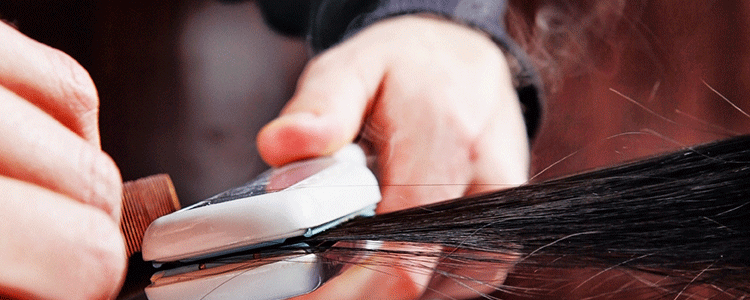Is “Formaldehyde-Free” Really Formaldehyde-Free?
 |
| Jamie McConnell Director of Programs & Policy |
In 2010 when Brazilian Blowout and other keratin hair straightening treatments were found to contain high levels of formaldehyde some manufacturers started to make “formaldehyde-free” formulations. But are these products really safer? The answer, unfortunately, is probably not.
Turns out while many “formaldehyde-free” hair straighteners do not technically contain formaldehyde as an ingredient, they do contain other chemicals that release formaldehyde when in contact with high heat. The problem is, high heat (usually from both a hair dryer and a flat iron) are necessary in order for these straightening treatments to work.
Specifically, the chemicals most commonly seen in “formaldehyde-free” hair straighteners are of two different types. The first type includes glyoxylic acid and glyoxyloyl carbocysteine, and the second type includes silicones such as cyclopentasiloxane, dimethicone and phenyl trimethicone. All of these chemicals emit formaldehyde at high heat, such as the 450 F heat of a flat iron. (Click here to see the science on the thermal breakdown of glyoxylic acid into formaldehyde, and here for a study on formaldehyde release from heating silicones.) But perhaps even more obvious warnings can be found on the Safety Data Sheets (SDSs) for these chemicals. For example, Section 10 of an SDS for cyclopentasiloxane states “Hazardous decomposition products will be formed at elevated temperatures” and specifically lists formaldehyde as a “decomposition product.” Section 10 of an SDS for glyoxylic acid warns that “excess heat” is a “condition to avoid”, and also lists formaldehyde as a hazardous decomposition product.
But how much formaldehyde is released from these new hair straighteners? Unfortunately there is relatively little data available to provide the answer. A very interesting (although unpublished) study presented at a conference of cosmetic scientists in 2012 did examine formaldehyde release from a “formaldehyde-free” hair straightener containing glyoxyloyl carbocysteine. For comparison they used the same methods for collecting data as had been used in a prior study on formaldehyde release from the simulated use of Brazilian Blowout and other formaldehyde-containing hair straighteners. Compared side by side, the “formaldehyde-free” product released about half as much formaldehyde as Brazilian Blowout into the air. Less formaldehyde is certainly better, but from a health perspective, it can hardly be called a safe product. And further to call it a “formaldehyde-free” product is entirely misleading.
To add to the misinformation about these products, many of the SDS sheets for the so-called formaldehyde-free products don’t list the risk of formaldehyde exposure as a result of application with high heat either. And ironically, some of the SDS even caution that high heat is a “condition to avoid” for the product—even though high heat is directed as a final step in the application process.
And I’m sorry to burst the bubble even more, but if you choose to straighten your hair with a flat iron at home, cyclopentasiloxane is also a common ingredient found in flat iron sprays (also called thermal protection sprays) you can purchase at retail stores. That’s right, if you flat iron your hair after spraying these products, you may be releasing formaldehyde into the air of your very own home!
So what’s a curly haired woman to do? If you don’t want to embrace the natural beauty of your locks, here are a few suggestions:
1. Read product labels carefully before straightening your hair with heated tools (either at home or in the salon). Avoid heating products containing these chemicals:
- glyoxylic acid
- glyoxyloyl carbocysteine
- cyclopentasiloxane
- dimethicone
- phenyl trimethicone
2. Share this information with your stylist, who may be misinformed by the marketing materials and SDSs of the products they use.
3. Take Action! To tell the FDA to recall toxic hair straighteners click here.
For more information about our work on formaldehyde in hair straighteners click here.




Thanks for this…. I recently did a full analysis of the ingredients in the smoothing treatment I had been using on clients for about 5 years- Pravana Perfection, and it contains both glyoxyloyl carbocysteine and cyclopentasiloxane! I still have been having some slight issues since I stopped doing Brazilian Blowout 5 years ago and I thought it was after effects of Brazilian Blowout, but it looks like it may be the Pravana treatment! Needless to say I am stopping that as well. The treatment recommends a temperature of 360 degrees on the flat iron, but I usually bump it to 400 degrees. Now I see why they recommend that, so it’s not releasing the formaldehyde it clams not to have! The ironic thing is Pravana claims that their product is extremely safe, safe enough for pregnant and nursing women and of course I believed it. Unfortunately I have been having fertility issues and am worried it may be related to these treatments.
Dear Jamie:
My name is Javier Jaen, I am a chemist and work in the manufacture of cosmetics. Your article is very interesting but I must be honest, it have faults, that cause people who read it wrong concepts form.
the SDS of cyclopentasiloxanes show the warning that can form formaldehyde when heated to high temperature ……. this happens in very specific conditions, such as temperatures of a fire.
In the case of glyoxylic acid, the study to which you refer was doing in particular conditions in which it is accomplished by heating with a laser and an atmosphere of SF6.
It would be very interesting a study of atmospheric concentrations of formaldehyde in the working conditions of salon, when these compounds are used. But with the information you have is not correct to say that products are dangerous.
Javier
Thanks for your comments. We certainly agree that we need more research to assess the levels of formaldehyde produced in salon conditions using these hair products containing siloxanes and glyoxylic acid. However, we believe that the data we do have that we reported on in our blog justify our concerns.
For one, these products have been brought on the market in response to the valid concerns and harm caused by hair straighteners that contain high levels of formaldehyde. The products containing siloxanes and glyxoyxlic acid are marketed as being formaldehyde-free. We find that this is inaccurate when these are products likely to emit formaldehyde when used as directed.
Secondly, the thermal decomposition into formaldehyde from both siloxanes and glyoxylic acid shown in the studies we link to demonstrate formaldehyde generation at temperatures likely to occur in salons. These products are intended to be used with flat irons at 450 degrees Fahrenheit (505 Kelvin, 232 Celsius). We have heard that some flat irons can reach temperatures up to 550 degrees Fahrenheit. (We agree that the results of the laser-induced decomposition of glyoxylic acid in the one article are not relevant, but the thermal decomposition of glyoxylic acid at temperatures starting at 355K from that same study are relevant to making our point.)
The limited data from the one study we mention that was done in a salon on a product formulated with glyoxylol carbosysteine (which is made from glyoxylic acid) did show that the levels of formaldehyde generated from their use was about half of what is generated by Brazilian Blowout. Half is better – but it in no way represents “formaldehyde-free”.
Lastly, the main reason that we are raising awareness about the potential for formaldehyde generation from these products is that we have heard from stylists whose health was affected by formaldehyde-containing Brazilian Blowout. They have asked us why they are still reacting to products that claim to be formaldehyde-free – and it turns out they are reacting to products containing siloxanes and glyoxylic acid.
We hope that our blog helps consumers and stylists alike be aware of the potential risks of these products, brings our concerns to the attention of the FDA and drives more research to better understand their potential for formaldehyde generation in salons.
Thanks again for your comments
Alexandra Scranton
Director of Science and Research
Women’s Voices for the Earth
Dear Elizabeth:
A lot of Thanks for your comments!
Concern about health is more important than beauty or money !
Not only is formaldehyde, some chemicals are very dangerous, knowledge and management of these, by beauty professionals should be a priority in their training.
And it should be a concern of health authorities in all countries.
I tested products based on glyoxylic acid and formalin and the difference is very large.
I do not think that large amounts of formaldehyde are generated under the conditions of salon, it does not cause eye irritation. Also when the hair is heated, which probably happens is that the acid boils, bp111 °C, well below the temperature at which it is assumed it decomposes in formalin >200 °C.
Of course this is no guarantee of inoquidad: for the same acid vapor causes discomfort by breathing and other substances that remain in the hair derived from glyoxylic gases could generate problems with the ironing.
For this reason some manufacturers ask wash the hair after an exposure time before drying and ironing, this greatly reduces vapor. I think this is an achievement and is due in part to your article and I congratulate you for that.
There are still companies I use formaldehyde in their products and the first effort should be made to seek it removed altogether.
There are no studies of toxic gases formation under the heat of the hair iron, not only formaldehyde and not only with silicones and derivatives of glyoxylic acid are needed.
Did you mention, one study, that was done in a salon, with a product formulated with glyoxylol carbosysteine did you have this report .?
Best regards,
I have been an innovative stylist for 20+ years and have found ALL Keratin treatments to be toxic….the latest in treatments as well….once the heat hits the hair, there is a gas/smoke that emits into the air…It is a huge irritant, burning my lungs and eyes..I have to avoid the salon whenever a stylist is administering one….and would NEVER subject my clientele to the chemicals in ALL Keratin treatments! I want to add that I have NEVER seen a result that looks natural and shiny…especially after a month…I continue to see breakage and a synthetic feel to the hair whenever I have a client sitting in my chair that has had one done. Outlawed in many other countries that more than recognize the toxicity..once again our country lags behind…money and profit winning out over safety, environmental responsibility, and integrity…
I am most grateful for your research and your efforts. It is troubling the way the FDA is so slow to act. The average person cannot be expected to see past the false-advertising and do their own research.
This is truly scary what formaldehyde does to the liver beginning specifiacally page 23/25 …when inhaled
http://jem.rupress.org/content/jem/6/4-6/487.full.pdf
Hola quisiera saber si desde el tiempo en que se realizó este post hasta la actualidad se tienen más datos referentes a este estudio.
El producto proliss 100 que se está utilizando ahora en tratamientos para alisar el cabello se compone básicamente de glioxyloyl carbocisteine y glioxyloyl keratin. ¿Alguien sabe sobre este segundo elemento?
Tienen más información?
Hi Julie, I noticed you wrote this in 2016. Do you have any updates to share? Any new studies about these ingredients?
Hello, do you think formaldehyde is dangerous to touch? If I have a gas mask during a brazilan blwout is it still dangerous?
Thanks
Is it safe to use a flat iron at home after using hair masks or other products containing dimethicone? My iron goes up to 400 F only, and I use it at 255 F.